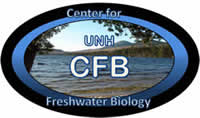Abstract
This study focused on the relationship between plankton in Mendums Pond, NH. A grazing experiment was conducted to determine the effect of zooplankton on the phytoplankton population. The phytoplankton were largely composed of net plankton (75 %) and this fraction was dominated by cyanobacteria (84.5 %) even though this was a slightly acidic system. Data indicated that the mean body length of zooplankton increased with depth. The average body length of Daphnia ranged from 1.4 mm in the epilimnion to 1.9 mm in the hypolimnion. Copepods followed a similar trend increasing in average body length from 0.85 mm to 0.95 mm. The high numbers of cyanobacteria and copepods resulted in a 17.92 % day-1 grazing rate indicating that almost 18 % of the total lake water was filtered every day by the zooplankton. This also suggests that the phytoplankton are reproducing at a higher rate than they are being consumed by grazers. This may raise concerns about the future diversity of the food web as cyanobacteria reproduce and become more dominant in this system.
Publication Date
1-1-2009
Publisher
UNH Center for Freshwater Biology Research
Document Type
Article
Recommended Citation
Marcek, Ben and Bunker, Jonathan, "Assessment of Pelagic Food Webs in Mendums Pond, NH" (2009). Center for Freshwater Biology. 4.
https://scholars.unh.edu/cfb/4

